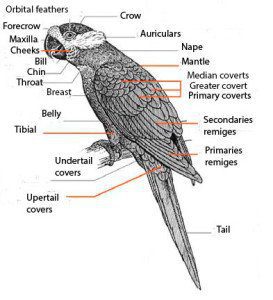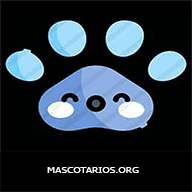Content
|
|---|
Description:
Of 32cm.. length and 117 g. of weight.
The Ouvea Parakeet (Eunymphicus uvaeensis) is similar to the Horned Parakeet (Eunymphicus cornutus) but with the face and nape green, no yellow, and crest upturned six pens greenish black: the Red of the crown It is limited to the center forecrown.
The Ouvea Parakeet generally bright mid-green. Head green, lighter on ear-coverts with some light shaft-streaks; centre of forecrown red with six wispy blackish-green uperwing feathers forming a small crest; rear-crown darker green; ears and cheeks dark green lower.
The upperparts light green, paler on rump. Wing coverts green; outerweb of primaries greenish-blue with innerwebs black. Underwing-coverts green. Underparts light yellowish-green. Uppertail green with a slight blue suffusion distally and blue edges to lateral feathers; undertail gray.
Bill blue-gray at base, blackish toward tip; irises orange; legs grey.
Both sexes similar.
Taxonomic status:
This taxon is considered a subspecies of Eunymphicus [cornutus or uvaeensis] (sensu lato) by some authors
- Sound Uvea Parakeet.
Note:
some species, as in the case of Ouvea Parakeet, They are subject to extreme stress due to traps or harassment. The open availability of high-quality recordings of these species may make the problems even worse.. For this reason, transmission and download of these recordings is off. Recorders are free to share in xeno-edge, but they will have to approve access to these recordings.
We do not take this action lightly, and we wish it wasn't necessary, but we are convinced that the negative impacts of offering easy access to these recordings outweigh the benefits. To access these recordings, You can contact directly with the recorder.
Habitat:
It is restricted to areas of old growth forest with holes for nesting, but the highest numbers occur near papaya plantation areas.
The Ouvea Parakeet They are active in early morning and late afternoon, and usually rest in the trees during the heat of the day.
Reproduction:
An average of 2.9 Eggs are laid in one or two broods per year, of which 1.7 chicks hatch, but only 0.75 chicks survive to 30 days (Robinet et al. 1995, Robinet et al. 1996, Robinet and Salas 1999).
Food:
It feeds in the forests and crops of cultivated land adjacent. The Ouvea Parakeet It depends mainly on mature native forests with pines kauri Agathis australis.
Fruits of Ficus spp., there Canaria, scrub and passion fruit. Also forage for seeds. The cultivated papaya (Carica papaya) It is a favorite.
Distribution and status:
Population expansion (breeding/resident): 640 km2
Los Pericos Uvea are confined to 110 km2 in Ouvea island, Loyalty Islands. Introduced unsuccessfully in the nearby Lifou.
The species is found in isolated patches of forest now restricted to the coast, mainly in the district St Joseph between Cape Rossel and Cape Steep. Single 15-25 km2 of suitable habitat was considered to remain on the island in 1993, with about 70-90 birds present, although a more thorough study has suggested a total population of 617 individuals. More recent studies is estimated at 1.780 mature individuals in total (Theuerkauf s suffering. 2016)
In the past, the reduction of individuals to extensive conversion of forests for agriculture due, hunting and trade. The delicate political situation in Uvea, while Kanak Liberation Front struggle for independence France, It has hampered the work of conservation of the species.
It is relying on a captive breeding program based on Forest Park, about Noumea, in New Caledonia. Transfers from island to island also be considered feasible.
Conservation:
• Current category of the Red List of the UICN: Vulnerable.
• Population trend: Growing.
• Population size : 600-1800 individuals.
Rationale for the Red List category
This species is classified as Vulnerable because it is in one very small island and can be threatened by invasive species, in particular the Black rat, that could bring the species to the category of Critically Endangered or Extinct in no time.
Justification of the population
The population is estimated at 1.780 mature individuals in total (Theuerkauf s suffering. 2016), rounded here to 1.800 mature individuals.
Justification trend
Barré et al (2010) reported that the population has increased in a 29% (of 10 birds / km2 34 birds / km2) between 1993 and 2009, which equates to an increase in population 34% in three generations.
"Ouvea Parakeet" in captivity:
The Ouvea Parakeet they are still captured using a rope inside a fruit Upload papaya, and because the island is a plain, exports through an easily accessible atoll are difficult to control. Birds bought from trappers by 50 dollars can be sold by traders up 1.000 Australian dollars.
There is a captive breeding program, but it hasn't started yet, and the species is found only in small quantities in captivity for a very limited reproductive success (Tap 1996).
Alternative names:
– Horned Parakeet (Ouvea), Ouvea Parakeet, Short-horned Parrot, Uvea Parakeet (English).
– Nymphique d’Ouvéa, Perruche cornue (Ouvéa), Perruche d’Ouvéa, Perruche d’Ouvéa (French).
– Ouvéahornsittich, Uveasittich (German).
– Periquito-de-uvea (Portuguese).
– Perico de Uvea (español).
scientific classification:

– Order: Psittaciformes
– Family: Psittaculidae
– Gender: Eunymphicus
– Scientific name: Eunymphicus uvaeensis
– Subpoena: (Layard, THE & Layard, ELC, 1882)
– Protonimo: Nymphicus uvaeensis
Images:
Videos "Ouvea Parakeet"
Sources:
• Avibase
• Parrots of the World – Forshaw Joseph M
• Parrots A Guide to the Parrots of the World – Tony Juniper & Mike Parr
• Birdlife
Photos:
(1) – This Uvea Parakeet was photographed feeding on a papaya at the edge of forest by Tunpin.ong [CC BY-SA 3.0], from Wikimedia Commons
- Sounds: Patrik Åberg, XC40145. accessible www.xeno-canto.org/40145


